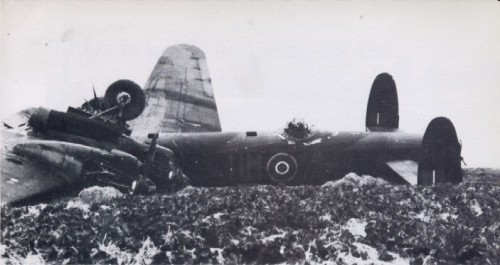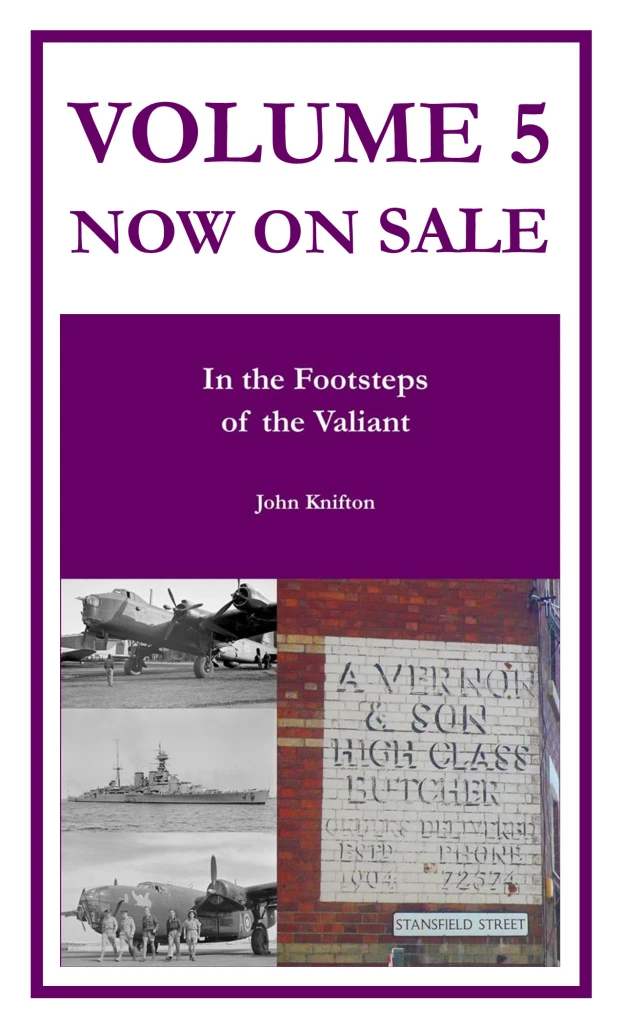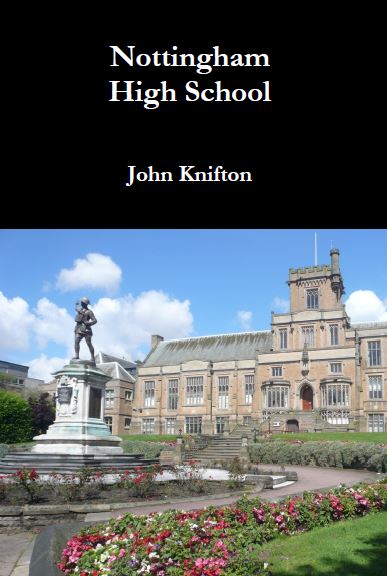This post is about an Avro Lancaster III of 61 Squadron, serial number DV 232, squadron letters QR-K. They took off, one of many, at 20:15 on September 5th 1943, from RAF Syerston near Nottingham to go and bomb Mannheim. This was a huge operation and involved 605 aircraft including 299 Lancasters, 195 Halifaxes and 111 Stirlings.
This is a Lancaster:
This is a Halifax:
And this is a Stirling:
Of the 605 aircraft, 34 were lost, some 5.6% of the attacking force, an unsustainable casualty rate.
On their way to the target, Lancaster DV 232 and QR-K had severe engine problems, with the port outer engine failing and the pilot unable to maintain height. And then the port outer engine caught fire. Pilot Officer Peter Todd, the pilot, extinguished it and feathered the propeller. The decision was taken to carry on and not to bale out. The aircraft’s 4,000lb cookie and the rest of the bombload were all duly dropped on Mannheim from around 15,000ft:
The crew then turned for home, full of a strange mixture of trepidation and perhaps misplaced hope. All credit to the plane, though, as the aircraft flew on sedately with Todd at the controls. Eventually he crossed the North Sea, crossed the English coast and discovered that the crew still did not want to bale out, even though they were over English fields. They wanted to stick with the plane which had faithfully brought them so far. They finally reached RAF Syerston where Todd attempted a landing. It did not go too well as the three remaining engines all stalled and the bomber began to sheer over towards the left. Todd missed the airfield buildings but soon found himself skipping too low and too fast over a landscape of fields unfamiliar to him. To the south was the River Trent and eventually the aircraft somehow skidded to stop in the welcoming waters of the river:
The crew were all completely uninjured, floating gently on the river’s calm cold waters:
And just in case you were wondering, the Lancaster was removed by floating it downstream and then rescuing it from the foaming torrent on the southern bank where there was a large flat area just before the village of East Stoke.
This story also turns out to be a very good example of how paperwork often went wrong in WW2. “We had more important things to do than get the bloody paperwork right!” as one high ranking RAF officer once said.
I mentioned just recently that research nowadays, especially with the Internet, can reveal many, many details about the events of the Second World War. But sometimes, quite basic details are lost. One website therefore, the best one, I would say, gives the crew as
Pilot Officer PH Todd (pilot), Sergeant S Robson, (flight engineer), Flying Officer J Hodgkinson, (navigator), Sergeant VR Duvall, (bomb aimer), Sergeant W Housley, (wireless operator / air gunner), Flight Sergeant Patrick , Sergeant John Cartwright, (air gunner).
An RAF Forum says, though, that the original Todd crew, posted in to 61 Squadron from 1661 Conversion Unit on August 25th 1943, was:
Todd, Robson, Shergold, (navigator), Duvall, Housley, Debnam, (air gunner). Cartwright.
Sergeant Patrick came from 1654 Conversion Unit on August 25th 1943 and he replaced Debnam for their first operation on the 3/4th September 1943. This was a disastrous raid on Berlin with 316 Lancasters and 4 Mosquitoes. 22 Lancasters were lost, an unsustainable rate, just below 7.0%. At least 70 aircrew were killed:

In Berlin, destruction was caused to major water and electricity works and to one of the city’s largest breweries. A total of 422 people were killed, namely 225 civilians, 24 servicemen, 18 men and 2 women of the air-raid services, along with 123 foreign workers made up of 92 women and 31 men. Another 170 civilians were missing. Two delayed action bombs eventually went off and they killed a soldier and seven “criminals”….convicts who could earn remission of their sentence by volunteering for this work. Later in the war, of course, when they ran out of convicts, the Germans made extensive use of Jews for the manual transportation of apparently live bombs which had failed to explode.
The same crew which flew to Berlin was used to fly to Mannheim. They were the ones who returned ultimately to slither rather ignominiously into the River Trent. My belief is that they were:
Todd, Robson, Shergold, Duvall, Housley, Patrick, Cartwright
All of the crew were able, incidentally, to walk to the bank of the River Trent along the fuselage and then out through the front gun turret:










Was the brewery a strategic target?
I don’t think so, but I’ve always wondered why no “thinking outside the box” went on. Why not set fire to forests and harvest fields? And best of all, make sure that the city sewage works doesn’t function properly. Alas, nowadays it’s just one button pressed and the end of everything, boxes, harvests, sewage works and breweries. Thank goodness the people with their fingers on the button are trustworthy, intelligent and rational people with no crazy religious or philosophical beliefs.
I always thought that the Duke of Wellington could have made use of Agincourt archers at Waterloo if he had the imagination.
REPLY: I carried that idea around for decades myself until I got my chance to ask about it at the Armouries Museum in Leeds when I went on a school trip there. Apparently the problem with archers is that they take so long to train….years in fact. Give a country bumpkin a musket and you can train him to kill in a day. And more or less every hit from a musket will disable the victim as the wounds are so horrendous. They are not too slow at firing either. With practice, you can fire every 30 seconds and one a minute seems to be a minimum. It’s a great (free) museum to visit by the way, with computer games simulating battles. They are tremendous!
Getting total accuracy certainly can be a challenge! One thing I have noticed is that crews were often dedicated to their aircraft and would not leave unless it was absolutely the last choice. A real partnership developed between them and it became part of the ‘family’.
I think you may well be right there although there are more posts on this in the future which will give the idea one or two twists and turns. I just wish that the people in charge at the end of the war had thought of preserving these various aircraft for generations in the future. It was actually quite difficult, if not impossible, to see a Wellington, while Hendon’s example was being revamped for two or three years. I only know of one other. And things such as Stirlings and even Halifaxes…I’m not so sure that there are any 100% pure aircraft of those two types left anywhere in this country.
Especially When you consider how many were left at the war’s end, it is truly tragic that there are so few examples left flying or in museums now.
Dear John,
Thank you for this. Another fascinating blog.
There is a Lancaster story which might interest you, of two bombers which crashed, within 3 weeks of each other in the latter stages of the War, in the same field next to the Trent at Hoveringham. The incidents were traumatic for the villagers, who unsuccessfully tried to rescue the (largely Commonwealth) crews in the early hours. The nature of the scene which confronted them, twice, has to be imagined. It was not spoken of in the village for many years, but the efforts of Helen Nall, who lives at Hoveringham Hall, eventually led to a memorial being erected in the 2000s.
Best wishes
Phil Turton
Sent from my iPad
Thanks very much for that. I will try to look into it if I have the time. From what my Dad told me, a crashed aircraft is a tremendous place to develop PTSD.
If you remember a thick set caretaker from the 1980s called Arthur, he fought in the Korean War and he told me ghoulish stories about what he and his pals had had to do after the battle. when it came to tidying up the hillside after the party from hell.
Glad that you are enjoying the blog posts, by the way.
Another amazing wartime story
Thank you Derrick. This is only the beginning! Some extraordinary things happened when men had to decide whether to bale out or not, although the desire to get home was always incredibly strong.
I can sympathize with you on trying to get the facts accurate!! But I can always count on you doing your level best. These stories are great and I hope eventually we get as many as possible preserved here for future generations to read.
Thank you for your kind words. What I am working on at the moment is what happened to the 105 young men who were killed from the school where I used to teach, so that at least one cohort of heroes has a chance not to be forgotten. After 70 years, through nobody’s fault, they largely have been forgotten, certainly in terms of what they were like as people, where they lived, their hobbies and so on. And as you say, you can only try your hardest to find out the facts, although in some cases, I am beginning to feel that I may have to admit defeat. Early days yet, though!
I have confidence that you will search all possible avenues.
I think that almost every single flight by a bomber crew, irrespective of the outcome, is the basis for a novel or a film. I don’t know how I would have coped.
The secret apparently was to think that whatever it was would happen to somebody else. There was also a very strong desire not to be seen as letting down the rest of the crew by being too frightened to do your job and just freezing up. Remedies to swing reality over on to your side included alcohol and superstition. The rubber on the rear wheels of Lancasters would begin to rot because so many men urinated on them so often for good luck.
It is always interesting to read your posts. And I always wonder about wars and other acts of violence. They have always happened and will always happen.
Thank you for your kind words. There probably will be violence and war in one form or another in the future, but we all need to make it our job to speak out and to suggest that differences can be settled by talking together.
The work you must put into some of these posts, John, to find the facts, is simply mind-boggling. So much of history is inaccurate. I applaud your efforts once again!!! 👏🏼👏🏼👏🏼
Thank you very much, Amy. I have to do something to keep me on the straight and narrow. I don’t want to be the only senior citizen devoted to wild women and whisky!
YOU are too funny!!! Keep on! 😘
Came across this from one of my old posts. It came from a copy of ‘Empire Youth Annual 1946’

I thought you may be able to identify it…
It’s a pity that the small red serial numbers are not visible. The VN-N establishes it as 50 Squadron but casualties were so high that one letter was often a lot of individual Lancasters, as is shown at
http://aircrewremembered.com/taylor-jcp.html
and http://www.teunispats.nl/t1953.htm
where VN-N is carried by two different Lancasters.
One letter might be up to 12 different aircraft over time, with their serial numbers being the difference. In those two websites the aircraft was W4266 and then it was replaced by DV324
A publicity photo shoot of one of the VN-Ns was done on August 28, 1942 and that is probably the aircraft whose photograph you found. It was R5689 and more pictures appear at
http://www.airpages.ru/eng/uk/ukphoto1.shtml
Overall, the serial number will tell you the individual aircraft and the squadron letters, VN-N will tell you which squadron and sadly, what level of casualties they had.
Excellent, thanks!
It’s amazing what happened in some of the fields you pass every day. They seem so quiet these days but were the scenes of some dramatic events.
They certainly were! That is what I find so disturbing about old photographs. If you have the original to navigate with, you can find the exact, precise spot where somebody stood in say, 1897, and you can stand, literally, in his footsteps. I did this at school once, where the bricks in the wall on an old photograph formed a unique code with their sizes…..short, short, long, short. long, long and so on. It made it easy to work out exactly where the original photograph had been taken.
That’s a great thing to be able to do. Much better than looking for “the dip in the field” or whatever other indication the book tells you to look for.